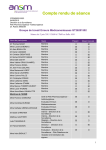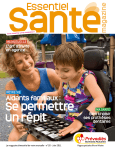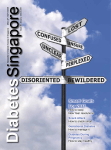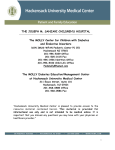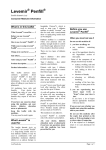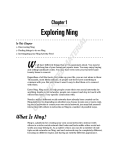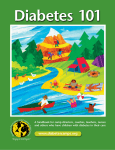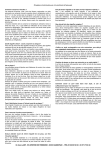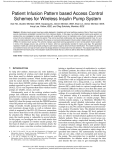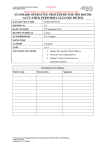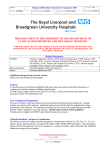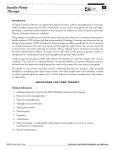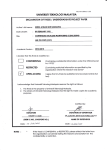Download PDF User manual
Transcript
ManageBGL User Manual PredictBGL App Last Update Revision Status Document : : : : For Users 23-Apr-15 1.3 Public release User Manual Web 1.3.docx Predict BGL App User Manual Table of Contents 1 IMPORTANT NOTES ...................................................................................................................... 4 1.1 1.2 1.3 1.4 2 NOTES ABOUT THIS MANUAL ...................................................................................................................... 4 ACRONYMS AND DEFINITIONS ..................................................................................................................... 4 WARNINGS .............................................................................................................................................. 5 RECALL ................................................................................................................................................... 6 GETTING PREDICTBGL ................................................................................................................... 7 2.1 3 DEVICE REQUIREMENTS ............................................................................................................................. 7 SIGN UP ....................................................................................................................................... 8 3.1 3.2 3.3 3.4 3.5 4 WEBSITE OR APP SETUP............................................................................................................................. 8 SYNCHRONIZATION ................................................................................................................................... 8 WELCOME SCREEN ................................................................................................................................... 8 LOGIN..................................................................................................................................................... 9 SIGN UP AND INITIAL SETTINGS ................................................................................................................... 9 INITIAL SETTINGS ........................................................................................................................ 10 4.1 STEP 1. TYPE, DIAGNOSIS, THERAPY ETC ..................................................................................................... 10 4.1.1 Diabetes Type ............................................................................................................................. 11 4.1.2 Year of Diagnosis ........................................................................................................................ 11 4.1.3 Therapy....................................................................................................................................... 11 4.1.4 Gender ........................................................................................................................................ 11 4.1.5 Enable Insulin Calculator ............................................................................................................ 12 4.1.6 Blood Glucose Units .................................................................................................................... 12 4.1.7 Carb Units ................................................................................................................................... 12 4.1.8 Dimensional Units (not currently used) ...................................................................................... 12 4.1.9 Location ...................................................................................................................................... 12 4.2 STEP 2. ACTIVE INSULIN TIME ................................................................................................................... 13 4.3 STEP 3. INSULIN SENSITIVITY ..................................................................................................................... 13 4.3.1 Determining your initial Insulin Sensitivity ................................................................................. 13 4.4 STEP 4. CARBOHYDRATE RATIO ................................................................................................................. 14 4.4.1 Determining your initial Carbohydrate Ratio ............................................................................. 14 4.5 INITIAL SETUP COMPLETE ......................................................................................................................... 15 5 DASHBOARD .............................................................................................................................. 16 5.1 BLOOD GLUCOSE CHART .......................................................................................................................... 16 5.2 GREEN DOTS – ACTUAL BGLS................................................................................................................... 17 5.3 RED DOTS – FUTURE HYPO OR HYPER WARNINGS ......................................................................................... 17 5.4 AMBER DOTS – COACHING SUGGESTIONS ................................................................................................... 18 5.4.1 Higher or Lower than Expected .................................................................................................. 19 5.5 SENSOR DATA – CGMS........................................................................................................................... 19 5.6 LOG SUMMARY ...................................................................................................................................... 19 5.6.1 Estimated Blood Glucose ............................................................................................................ 20 5.6.2 Active Insulin .............................................................................................................................. 20 5.6.3 Estimated A1C %......................................................................................................................... 20 5.6.4 Hypos .......................................................................................................................................... 20 5.7 LOG A READING...................................................................................................................................... 20 6 LOG SCREEN ............................................................................................................................... 21 23-Apr-15 User Manual Web Page 1 1.3.docx:V1.0 Copyright © 2015 ManageBGL Pty Ltd Predict BGL App User Manual 6.1 BLOOD GLUCOSE .................................................................................................................................... 21 6.1.1 If your meter shows Lo or High ................................................................................................... 21 6.2 CARBOHYDRATES .................................................................................................................................... 21 6.2.1 Low BG Response........................................................................................................................ 22 6.2.2 Negative Insulin Response .......................................................................................................... 22 6.2.3 Delayed Eating Response ........................................................................................................... 23 6.3 EXERCISE ............................................................................................................................................... 23 6.4 DETAILED INFO – SEE LATER ...................................................................................................................... 24 6.5 INSULIN ................................................................................................................................................ 24 6.5.1 Active Insulin Remaining ............................................................................................................ 24 6.6 SAVE READING ....................................................................................................................................... 24 6.7 CARBOHYDRATE DETAILS.......................................................................................................................... 25 6.7.1 Meal Presets ............................................................................................................................... 25 6.7.2 GI Factor ..................................................................................................................................... 25 6.7.3 Hypo Treatment.......................................................................................................................... 25 6.7.4 Protein ........................................................................................................................................ 26 6.7.5 Fat............................................................................................................................................... 26 6.7.6 Food database ............................................................................................................................ 26 6.8 DETAILED INFO ....................................................................................................................................... 27 6.8.1 Factors ........................................................................................................................................ 27 6.8.2 Feelings....................................................................................................................................... 28 6.8.3 Notes .......................................................................................................................................... 28 6.8.4 Basal Insulin................................................................................................................................ 28 7 LOG HISTORY DISPLAY ................................................................................................................ 29 8 PROFILE ..................................................................................................................................... 30 9 SETTINGS ................................................................................................................................... 31 9.1 GENERAL............................................................................................................................................... 31 9.2 INSULIN ................................................................................................................................................ 31 9.2.1 Fast Acting 1 ............................................................................................................................... 32 9.2.2 Insulin Sensitivity ........................................................................................................................ 32 9.2.3 Active Insulin Time...................................................................................................................... 32 9.2.4 Minimum Dose ........................................................................................................................... 32 9.2.5 Maximum Dose .......................................................................................................................... 32 9.2.6 Slow Acting 1 .............................................................................................................................. 32 9.2.7 Model Basal Insulin .................................................................................................................... 33 9.2.8 Basal Times ................................................................................................................................. 33 9.2.9 Basal Rate ................................................................................................................................... 33 9.2.10 Natural Pancreas Function ......................................................................................................... 33 9.2.11 Advanced Factors ....................................................................................................................... 34 9.3 BLOOD GLUCOSE .................................................................................................................................... 35 9.3.1 Low and High Range ................................................................................................................... 35 9.3.2 Set Glucose Targets .................................................................................................................... 35 9.3.3 Connect Devices – Blood Glucose Meters ................................................................................... 36 9.3.4 Connect Devices – CGM Devices ................................................................................................. 36 9.4 CARBS .................................................................................................................................................. 36 9.4.1 Default GI Factor ........................................................................................................................ 36 9.4.2 Meal Time Defaults .................................................................................................................... 37 9.4.3 Carb Ratio ................................................................................................................................... 37 9.4.4 Hypo/Low Blood Sugar Treatment ............................................................................................. 37 9.4.5 Protein and Fat Factors .............................................................................................................. 38 9.5 EXERCISE ............................................................................................................................................... 38 9.6 LOW/MEDIUM/HIGH INTENSITY LEVELS ..................................................................................................... 38 23-Apr-15 User Manual Web Page 2 1.3.docx:V1.0 Copyright © 2015 ManageBGL Pty Ltd Predict BGL App User Manual 9.6.1 Basal Sugar ................................................................................................................................. 39 9.6.2 Connect Devices – Fitness Devices .............................................................................................. 39 9.7 REPORTS ............................................................................................................................................... 39 9.8 EMERGENCY CONTACTS ........................................................................................................................... 39 9.9 SHARING AND DEVICES ............................................................................................................................ 39 9.9.1 Share with Health Care team ..................................................................................................... 39 9.9.2 Share with some other bod ........................................................................................................ 39 9.9.3 Connect devices via .................................................................................................................... 40 9.10 HELP AND FEEDBACK ............................................................................................................................... 40 9.10.1 Help Manual (PDF) ..................................................................................................................... 40 9.10.2 PredictBGL Forum ....................................................................................................................... 40 9.10.3 Email Support ............................................................................................................................. 40 9.10.4 Skype .......................................................................................................................................... 40 9.10.5 Phone .......................................................................................................................................... 40 9.10.6 TuDiabetes Forums ..................................................................................................................... 40 9.10.7 DiabetesMine ............................................................................................................................. 40 9.10.8 Book a Diabetes Educator .......................................................................................................... 41 9.10.9 Find a Local Diabetes Organisation ............................................................................................ 41 9.10.10 Add Diabetes Organisation..................................................................................................... 41 9.11 POINTS ................................................................................................................................................. 41 9.12 DID WE DO WELL? RATE US! ..................................................................................................................... 41 9.13 COACH ................................................................................................................................................. 41 9.14 SOCIAL.................................................................................................................................................. 41 9.15 MORE LOG TYPES (WEIGHT, A1C RESULTS, ETC) ........................................................................................... 41 9.16 ABOUT / LEGAL ...................................................................................................................................... 42 9.16.1 Privacy ........................................................................................................................................ 42 9.16.2 Labelling ..................................................................................................................................... 42 9.16.3 Terms of Service ......................................................................................................................... 42 9.16.4 Regulatory .................................................................................................................................. 42 9.16.5 Adverse Event Reporting ............................................................................................................ 42 9.16.6 Version ........................................................................................................................................ 42 9.16.7 Force Sync Now .......................................................................................................................... 42 9.16.8 Discard Local Data and Re-download......................................................................................... 42 9.16.9 Log out........................................................................................................................................ 42 10 ALCOHOL AND STANDARD DRINKS .......................................................................................... 43 10.1 10.2 10.3 HOW MUCH IS TOO MUCH? ...................................................................................................................... 43 HOW DOES ALCOHOL AFFECT A PERSON WITH TYPE 1 DIABETES? ..................................................................... 44 ALCOHOL AND HYPOS .............................................................................................................................. 44 11 TROUBLESHOOTING ................................................................................................................ 45 11.1 CHARTS................................................................................................................................................. 45 11.1.1 Rises – constant slope straight lines ........................................................................................... 45 11.1.2 Drops – constant slope straight line ........................................................................................... 45 23-Apr-15 User Manual Web Page 3 1.3.docx:V1.0 Copyright © 2015 ManageBGL Pty Ltd Predict BGL App User Manual 1 Important Notes Thank you for choosing PredictBGL to help you gain better control of your diabetes. PredictBGL is a bolus calculator and blood glucose prediction system designed for tracking patterns and detecting trends in blood glucose levels in people with diabetes. The system is intended for use in individual patients. PredictBGL aids in the detection of episodes of hyperglycemia and hypoglycemia. It alerts you to these so that you can adjust your therapy- both in the short-term, and for the future. By doing this it can help you to reduce the number of times that your blood sugar levels are too high or too low. It is important that PredictBGL is set up correctly. Its calculations are based on your personal settings and the information that you put into it. The more accurate your settings are, the more accurate the suggestions will be. It will take you time to tweak your settings and get your ratios right – but don’t give up, it’s worth it! 1.1 Notes about this Manual This manual has been written for the diabetes community world-wide. As such, both mmol/L and mg/dL units are used for Blood Glucose levels in both screen displays and in this text. PredictBGL adjusts its display depending on what your preferences are. Similarly for carbohydrates – PredictBGL supports grams, Exchanges, Portions, KE, CC and BE measures. PredictBGL will display the one you prefer. The screen displays may differ slightly from what you see in this manual due to your choice of settings. 1.2 Acronyms and Definitions Active Insulin Time Basal insulin BGL/BSL Bolus insulin Carbohydrate counting Carbohydrate ratio CGM(S) Dawn phenomenon Diabetes educator The amount of time your short acting insulin acts for. The insulin that controls blood glucose levels between meals and overnight. It controls glucose in the fasting state. Blood Glucose Level/Blood Sugar Level The insulin that is released when food is eaten. It is also the name for a burst of insulin that is delivered by injection or by the insulin pump to “cover” a meal or snack or to correct for a high blood glucose level. A meal planning method commonly used by people with diabetes to plan their food and meal choices. Carbohydrate counting helps achieve a balance between the amount of carbohydrate foods eaten and the available insulin. A method of determining how much rapid-acting insulin is needed to cover the carbohydrate eaten at a meal or snack. This is used as part of a more advanced level of carbohydrate counting. Continuous Glucose Monitor (ing System). A device that measures blood sugar every five minutes through a sensor inserted under the skin. A rise in blood glucose levels that occurs in the early morning hours A healthcare person who has the skill and knowledge to teach a person with diabetes how to manage the condition. Diabetes educators may be doctors, nurses, dieticians, mental health or fitness clinicians. Some also have the credential CDE (Certified 23-Apr-15 User Manual Web Page 4 1.3.docx:V1.0 Copyright © 2015 ManageBGL Pty Ltd Predict BGL App User Manual Endogenous GI HCP Honeymoon period Hyperglycaemia or ‘hyper’ or ‘high’ Hypoglycaemia or ‘hypo’ or ‘low’ Hypoglycaemic unawareness Insulin pen Insulin pump Insulin sensitivity factor IOB (Insulin on Board) PHI Pumper PWD Diabetes Educator) From within- for example, insulin from own pancreas, which may be functioning in some capacity Glycaemic Index - how fast the carbohydrate content of food hits the blood stream. High GI foods are absorbed quickly and cause a ‘spike’ in blood sugars. Spikes in blood sugar cause progressive damage to fine blood vessels in the eyes, hands, feet, heart and kidneys. Health Care Provider e.g. doctor, endocrinologist, educator, dietician, nurse etc. After diagnosis of Type 1 diabetes, a period of time when the body initially returns to producing some insulin. Some Type 1s do not require insulin during this period, others require far less. A high blood sugar level. A low blood sugar level. A condition where a person no longer recognizes the symptoms of low blood glucose. An insulin delivery method that looks like a writing pen. An insulin delivery system; a small mechanical device, typically the size of a beeper or small cell phone, that releases insulin into the tissues of the body by way of tubing and a needle. (also called the correction factor or supplemental factor) - The amount of blood glucose that is lowered by 1 unit of rapid-acting or regular insulin. The insulin sensitivity factor is used to calculate the amount of insulin you need to return blood glucose to within your target blood glucose range. Insulin on Board – the amount of insulin remaining to be absorbed- calculated using the time it was injected, the Active Insulin time and the size of the dose. Personal Health Information A person using an insulin pump. Person or People With Diabetes 1.3 Warnings PredictBGL is primarily intended for PWD (People With Diabetes) who use insulin as part of their treatment regime. However, it can also be useful for those not on insulin. PredictBGL is intended for use by a single PWD. Do not share an account with another PWD. Guessing or using the wrong settings can be dangerous! Ask your healthcare professional for assistance in setting up PredictBGL, and in making any future changes. If you give PredictBGL the wrong data, the information it gives you can be misleading or wrong. And just like when managing diabetes without PredictBGL, you must decide if PredictBGL's advice is relevant and appropriate to you. Do not allow young children to play with PredictBGL’s settings. 23-Apr-15 User Manual Web Page 5 1.3.docx:V1.0 Copyright © 2015 ManageBGL Pty Ltd Predict BGL App User Manual 1.4 Recall If we identify a serious bug in the PredictBGL App version that you have, you will see a message similar to that shown. We advise you to update your version of PredictBGL whenever you see one of these messages. Note that we do not force you to download an update straight away, because it is possible that downloading at that time may not be convenient eg. about to get on a plane. 23-Apr-15 User Manual Web Page 6 1.3.docx:V1.0 Copyright © 2015 ManageBGL Pty Ltd Predict BGL App User Manual 2 Getting PredictBGL You can download the PredictBGL App from the Apple App Store or Google Play (for Android). If your device is damaged, lost or stolen, you can also access PredictBGL directly from the ManageBGL.com website with the same login information. 2.1 Device Requirements PredictBGL runs on any web browser on a PC, Mac, iPhone, iPad, iPod or Android smart phone or tablet. 23-Apr-15 User Manual Web Page 7 1.3.docx:V1.0 Copyright © 2015 ManageBGL Pty Ltd Predict BGL App User Manual 3 Sign Up Before you can use PredictBGL, you need to create an account using your email address and password. 3.1 Website or App Setup PredictBGL can be setup either via the PredictBGL app, or via the ManageBGL website. The ManageBGL website may be easier to setup for some people as you have use of a full keyboard, larger screen and mouse. The ManageBGL website can also enter items not available in the App user interface, such as your avatar (image/photo), and recording of extra data such as eye tests. Future development of the App will allow this. 3.2 Synchronization The App and the website have been designed to work together and synchronize data between them automatically. Data entered in the App should normally appear on the website within 2.5 minutes, and on other Apps within 5 minutes If there are events that may disrupt power and phone connections (storms, fire) this may take longer. You can always check the time that the data was last synchronised, on your Dashboard. This enables you to use the website on your computer at work or home, and on your smart phone or tablet when you are out and about. 3.3 Welcome Screen When PredictBGL starts, you will see the welcome screen. If you already have an account, press the [Login] button. If you need an account, press the [Sign Up] button. 23-Apr-15 User Manual Web Page 8 1.3.docx:V1.0 Copyright © 2015 ManageBGL Pty Ltd Predict BGL App User Manual 3.4 Login Enter your email address and password on the login screen. The login screen will remember your email address for 2 weeks from the time you last used it. If you have forgotten your password, press the ‘I forgot my password’ link and follow the instructions. 3.5 Sign Up and Initial Settings To sign up, enter your first name, last name, email address and password. The password must have a mixture of at least 4 letters and/or numbers. Before pressing [Sign Up], you must accept the terms and ensure that PredictBGL is appropriate for you. After Sign Up, the next screen is the initial settings. 23-Apr-15 User Manual Web Page 9 1.3.docx:V1.0 Copyright © 2015 ManageBGL Pty Ltd Predict BGL App User Manual 4 Initial Settings If unsure about any of these settings, please contact your Health Care Professional. Press [Get Started] to continue. 4.1 Step 1. Type, Diagnosis, Therapy etc PredictBGL tailors displays and coaching advice based on the settings you give it. Please do not skip any settings. Please see below for detailed information on why we ask for particular information. 23-Apr-15 User Manual Web Page 10 1.3.docx:V1.0 Copyright © 2015 ManageBGL Pty Ltd Predict BGL App User Manual 4.1.1 Diabetes Type Choose your diabetes type(*), from: Type 1 Type 1.5 Type 2 Gestational Prediabetes LADA Other None - I do not have diabetes (*) If your body still makes insulin or you are in the “honeymoon period “ of Type 1 diabetes, then, use the Natural Pancreas setting (see page 33) to simulate this. 4.1.2 Year of Diagnosis In what year were you diagnosed? PredictBGL uses this to prompt you for eye checks and other tests. These tests are initiated after a period of time with diabetes, and pickup early warning signs of larger problems, such as kidney failure, blindness, heart disease and eye damage. 4.1.3 Therapy This determines what other data you will need to enter in the setup process which then allows for more accurate predictions. How is your diabetes treated? Choose from: Oral Medication Insulin cannot be logged. Insulin Therapy Insulin can be logged. Insulin and Oral Medication Insulin can be logged. Diet and Exercise (Only) Insulin cannot be logged. Other Insulin cannot be logged. N/A Insulin cannot be logged. 4.1.4 Gender Unknown Menstruation(*) is available as a factor. Male Menstruation is not available as a factor. Female Menstruation is available as a factor. (*) During Menstruation, more insulin is needed compared to normal. By personalising the Menstruation factor (see page 34), and then ticking the menstruation factor during a dose calculation (see page 27), insulin doses are magnified accordingly. 23-Apr-15 User Manual Web Page 11 1.3.docx:V1.0 Copyright © 2015 ManageBGL Pty Ltd Predict BGL App User Manual 4.1.5 Enable Insulin Calculator Disable the Insulin Calculator if you DO NOT use Humalog, NovoLog, NovoRapid or Apidra. Enable the Insulin Calculator if you use Humalog, NovoLog, NovoRapid or Apidra with Lantus or Levemir and vary your Insulin amount according to the size of each meal and your current blood sugar. 4.1.6 Blood Glucose Units Used for logging Blood Glucose data. mg/dL USA, Parts of Europe mmol/L Australia, UK, Parts of Europe 4.1.7 Carb Units Used for logging how much carbohydrate you consume. Choose from: Unit Name Each Unit Is Grams 1 gram Exchanges 15 grams Portions 10 grams BE (bread units, used in Europe) 12 grams KE (bread units, used in Europe) 10 grams CC (used in Europe) 15 grams 4.1.8 Dimensional Units (not currently used) Used for logging weight and height. Choose from: Metric Kg, cm Imperial Pounds, feet/inches 4.1.9 Location PredictBGL reads your device settings to determine the time zone. Your device should be set to update the time zone automatically, so that if you move between time zones (e.g. fly on a plane), the time zone will update automatically. E.g. if you fly from New York to London, PredictBGL will then display all data and suggests meals for London’s time zone. PredictBGL uses the time zone to choose which blood glucose target, carb ratio and insulin sensitivity is used for dose calculations. Any insulin you injected during the flight will still be tracked perfectly, as internally all times are stored in UTC/GMT. When you fly back to New York, PredictBGL will update the time zone when you land. 23-Apr-15 User Manual Web Page 12 1.3.docx:V1.0 Copyright © 2015 ManageBGL Pty Ltd Predict BGL App User Manual 4.2 Step 2. Active Insulin Time If you DO NOT use a bolus insulin such as Humalog, NovoLog, NovoRapid or Apidra then use a setting of 3 hours, and do not use the Insulin Calculator. Active Insulin is the amount of time your fast acting insulin acts for. This setting tells PredictBGL how much insulin to subtract (Insulin on Board or IOB) before calculating a dose. Your healthcare professional can advise you on a starting value (typically 3 hours), but you must adjust it yourself based on trial and error. PredictBGL nominally uses 3 hours for a fast acting insulin profile (Humalog, NovoLog, NovoRapid, Apidra). The valid range is 2-8 hours. Iinsulin action time can vary from person to person. PredictBGL allows you to alter this 3 hour active insulin time if needed. If you use an insulin pump, then you may have to set PredictBGL’s Active Insulin time to a lower value than your pump, as PredictBGL tracks insulin more accurately than your pump. 4.3 Step 3. Insulin Sensitivity Your Insulin Sensitivity Factor (ISF) determines how much your blood sugar will drop in response to 1 unit of insulin. .It is also known as a 'Correction ratio' or ‘Correction Factor’. Your Insulin Sensitivity can vary throughout the day, and you normally need more insulin in the morning compared to the middle or end of the day to achieve the same drop in blood sugar level. e.g. at breakfast, you may need 3 extra units to drop your blood sugar from 10 mmol/L to 5 mmol/L (180 mg/dL to 90 mg/dL), but at dinner time you might only need 2 extra units for the same drop. Insulin Sensitivity is normally between 1.1-5.6 mmol/l (20-100 mg/dL). When you first setup PredictBGL, three common time periods are shown with a default value of 1 unit of insulin drops 3.0 mmol/L (54 mg/dL). You must personalise these values to reflect your own diabetes management. See your Health Care Professional if you need assistance. You may also find a worksheet helpful – https://www.managebgl.com/scenarios/calculatinginsulin-sensitivity-factor-ISF 4.3.1 Determining your initial Insulin Sensitivity If you use Humalog, Novolog or NovoRapid, the ‘100 Rule’ (*) provides a rule of thumb for determining your initial insulin sensitivity. If you measure blood sugar in mg/dL: 23-Apr-15 User Manual Web Page 13 1.3.docx:V1.0 Copyright © 2015 ManageBGL Pty Ltd Predict BGL App User Manual ISF = 1800 divided by your TDD (total daily dose) If you measure blood sugar in mmol/L: ISF = 100 divided by your TDD (total daily dose) (*) Note: This rules gives a good starting point, but you must be prepared to adjust your sensitivity if it is wrong for you. Also remember that your sensitivity can change throughout the day. 4.4 Step 4. Carbohydrate Ratio The Carbohydrate Ratio determines how much carbohydrate is covered by one unit of insulin. It is also known as a 'Carb ratio'. Your Carbohydrate Ratio can vary throughout the day, and you normally need more insulin in the morning compared to the middle or end of the day to cover the same amount of carbs. e.g. at breakfast, you may need 6 units of insulin for 45 grams carbs, but at dinner time you might only need 4 units for 45 grams. Example: If you had 30 grams of carbohydrate, and you gave yourself 1 units to cover it, and when the insulin has finished acting 2.5-3 hours later your BGL was similar to before eating, then your Insulin To Carb ratio is: 30 ie 30 grams of carbohydrate is covered by 1 Unit of Insulin, and the ratio is 30 grams per unit. Example 2: If you had 60 grams of carbohydrate, and you gave yourself 4 units to cover it, and if 2.5-3 hours later your BGL was similar to before eating, then your Insulin To Carb ratio is 60/4 = 15 grams per unit, ie 60 grams of carbohydrate is covered by 4 Units of Insulin. When you first set up PredictBGL, three common time periods are shown with a default value of 1 unit of insulin covers 10 grams. You must personalise these values to reflect your own diabetes management. See your Health Care Professional if you need assistance. You may also find a worksheet helpful https://www.managebgl.com/scenarios/calculatingcarbohydrate-ratio 4.4.1 Determining your initial Carbohydrate Ratio If you use Humalog, Novolog or NovoRapid, the ‘500 Rule’ (*) provides a rule of thumb for determining your initial carb ratio. 23-Apr-15 User Manual Web Page 14 1.3.docx:V1.0 Copyright © 2015 ManageBGL Pty Ltd Predict BGL App User Manual If you measure food in grams: Carb ratio = 500 divided by your TDD (total daily dose) If you measure food in Exchanges: Carb ratio = 33 divided by your TDD (total daily dose) (*) Note: This rules gives a good starting point, but you must be prepared to adjust your carb ratio if it is wrong for you. Also remember that your carb ratio can change throughout the day. 4.5 Initial Setup complete After initial setup, you are taken to the dashboard. There are some items that currently cannot be setup within the App, see page Error! Bookmark not defined.. 23-Apr-15 User Manual Web Page 15 1.3.docx:V1.0 Copyright © 2015 ManageBGL Pty Ltd Predict BGL App User Manual 5 Dashboard In the top left corner is your avatar (if you have set this up via the ManageBGL website). The pie chart around the Avatar shows the percentage complete of your profile. If it is not 100% full, press the Avatar to find out what items are missing (see page 30). The gear icon takes you to settings and reports (see page 31). The ‘Updated 20 mins ago’ text shows the date and time of last synchronisation. Pressing this text causes a sync to occur. You can use this to check that your most recent entries have been synchronised before you lock your phone. 5.1 Blood Glucose Chart The dashboard shows your blood glucose graph. The yellow line represents your blood glucose levels over a 6 hour period. Swipe the graph to move forwards/backwards in time. Green dots represent actual readings you’ve made. Press the green dot to find out the actual reading and time. Amber alert dots represent discrepancies between predictions and your actual blood tests –Press the amber dot for suggestions as to what could have gone wrong. The Red alert dots represent a predicted hypo/hyper warning in the future. Don’t ignore these! Press the red dot to find out what is predicted. Your normal zone (see page 35) is shaded differently in the centre of the chart. Your BGL target is shown as a dark green line (see page 35). 23-Apr-15 User Manual Web Page 16 1.3.docx:V1.0 Copyright © 2015 ManageBGL Pty Ltd Predict BGL App User Manual 5.2 Green Dots – Actual BGLs When you press a green dot, or actual BGL, PredictBGL shows you the measurements taken at that time. To clear this box, press anywhere in the green box. 5.3 Red dots – future Hypo or Hyper warnings When you press a red dot, or warning, PredictBGL shows you a prediction of future Hypos or Hypers. PredictBGL recommends that you perform a BG test at the indicated time. Even if your ratios are correct, it is possible for the predictions and actual blood sugars to not line up. If this happens repeatedly, you need to consider the suggestions and if they are right for you. To clear this box, press anywhere in the upper red title section. 23-Apr-15 User Manual Web Page 17 1.3.docx:V1.0 Copyright © 2015 ManageBGL Pty Ltd Predict BGL App User Manual PredictBGL also shows warnings for expected High Blood Sugars. 5.4 Amber dots – Coaching Suggestions If your blood sugar is higher or lower than expected, PredictBGL will mark the difference with an amber dot. When you press an amber dot, or coaching suggestion, PredictBGL shows you the difference between its predictions and your BGLs, and the reasons for this. You must decide for yourself if the suggestions make sense to you. Even if your ratios are correct, it is possible for the predictions and actual blood sugars to not line up. If this happens repeatedly, you need to consider the suggestions and if they are right for you. To clear this box, press anywhere in the upper amber title section. 23-Apr-15 User Manual Web Page 18 1.3.docx:V1.0 Copyright © 2015 ManageBGL Pty Ltd Predict BGL App User Manual 5.4.1 Higher or Lower than Expected The example chart shows a blood sugar at 4pm that was higher than expected. The actual blood sugar was 16.0, while the expected blood sugar was 10.0. The amber dot appears mid-way between the two. 5.5 Sensor Data – CGMS If you use a CGMS and link it to the ManageBGL website, your CGM data is shared live and is plotted on the chart against predictions. 5.6 Log Summary The log summary below the chart shows you several useful numbers. To modify previous log entries, press anywhere on the log summary line, or the > to the right of the line. 23-Apr-15 User Manual Web Page 19 1.3.docx:V1.0 Copyright © 2015 ManageBGL Pty Ltd Predict BGL App User Manual 5.6.1 Estimated Blood Glucose This shows what your estimated blood glucose is right now. If this shows ‘Do BGL’ or ‘-‘, it means that PredictBGL does not have enough information to estimate your Blood Glucose, and you need to do a blood test. The BGL is color-coded according to its level – Red, Green or Amber. If your Blood Glucose is too high, it may not appear on the chart, and the estimated blood glucose display will show ‘> 22.0’ or ‘> 396’, where ‘>’ indicates ‘greater than’. 5.6.2 Active Insulin This shows the amount of insulin still active. It counts down by itself as your insulin is absorbed. If this shows ‘Settings!’ this means that the active insulin time has not yet been set. 5.6.3 Estimated A1C % This shows an estimate of your A1C based on your previous 90 days readings (if available). 5.6.4 Hypos This shows the number of Hypos detected in the last 7 days. 5.7 Log a Reading Pressing ‘Log a Reading’ takes you to the log screen. 23-Apr-15 User Manual Web Page 20 1.3.docx:V1.0 Copyright © 2015 ManageBGL Pty Ltd Predict BGL App User Manual 6 Log Screen The Log screen is where you enter data. If calculation is enabled, the logging screen will automatically calculate a dose based on the data you enter. If calculation is not enabled (see page 12), you must enter the insulin amount yourself 6.1 Blood Glucose Enter your BGL here by clicking on it. To clear a BGL, just enter ‘0’. To fix a BGL, just enter the new value. If your BGL target has been set (see page 35), it shows what the target is, and your insulin action time (see page 13). If the BGL target is not set, it shows a warning message. The BGL is colour coded according to its level, Red, Green or Amber. Low BGLs also show a Hypo Warning. 6.1.1 If your meter shows Lo or High Most meters show ‘Lo’ or similar if the BGL is too low for it to measure accurately, or ‘Hi’ or similar if it is too high to measure accurately. If this happens, press the BGL field, and then press either the Lo or High button instead of typing a number: 6.2 Carbohydrates Enter your Carbs here by clicking on it. To clear the Carbs, just enter ‘0’. 23-Apr-15 User Manual Web Page 21 1.3.docx:V1.0 Copyright © 2015 ManageBGL Pty Ltd Predict BGL App User Manual If your default meal times have been set, it shows the meal time selected, and the carbs for this meal time will be pre-set in the carbs field (so you don’t have to enter them each time). It also shows what GI factor has been chosen for this food. This is most important for fatty foods such as pizza and lasagne, and can be set on the Carbohydrate Details screen by pressing ‘>’. If the meal times have not been set, it shows a warning message. For the Carbohydrate Details screen, see later in this section. 6.2.1 Low BG Response If your BGL is below 4 mmol/L (72 mg/dL), PredictBGL uses a Red button to tell you how many of your Hypo recovery food items (page 37) are needed to return to a normal BGL. If you agree to follow the suggestion, press the Red button to add this to the log, and remember to retest in 1015 minutes. If you will still need extra food, a Green button will show how much extra food is needed to counteract active insulin. If you agree to follow the suggestion, press the green button to add this to the Carbohydrates. 6.2.2 Negative Insulin Response If the food you are eating is not enough to counteract the insulin that you have already injected, PredictBGL shows a Green button showing how many extra carbs you may need to eat to offset insulin. In addition, if you have entered a BGL, it tells you when is the best time to eat these extra carbs. This allows your BGL to drop first, rather than having a high BGL for longer, which has long term health consequences and increases your A1C. If you agree to follow the suggestion, press the Green button. Depending on how low your BGL is, the suggestion may be to eat straight away, or to eat later. 23-Apr-15 User Manual Web Page 22 1.3.docx:V1.0 Copyright © 2015 ManageBGL Pty Ltd Predict BGL App User Manual 6.2.3 Delayed Eating Response If your BGL is above your High Range (page 35) and you are eating, PredictBGL tells you how long to delay eating. This allows your BGL to drop first, rather than having a high BGL for longer, which has long term health consequences and increases your A1C. See https://www.managebgl.com/resources/delayeating 6.3 Exercise Exercise modifies the dose calculation, in accordance with your settings (page 38), generally by reducing your insulin. Only one exercise factor can be chosen. When you select an exercise factor (and save), the factor starts running for a pre-determined length of time. To cancel a running exercise factor, log a new entry, and uncheck the factor. The factor will then be turned off at that point in time. This makes it easy to start and stop an exercise factor when you’re unsure of the exact duration. Exercise is divided into 3 intensities: 23-Apr-15 User Manual Web Page 23 1.3.docx:V1.0 Copyright © 2015 ManageBGL Pty Ltd Predict BGL App User Manual Exercise Intensity Use for Default Duration Default % Low Impact Walking 4 hours -10% Medium Impact Tennis, swimming, light aerobics 4 hours -20% High Impact High impact aerobics, bike classes, karate, body pump and very high aerobic output exercise 4 hours -40% See Exercise Settings, page 38. 6.4 Detailed Info – see later For the Detailed Info screen, see page 26. 6.5 Insulin The insulin section will show a calculated dose if the dose calculator is on (page 12). You can override this dose by pressing the Insulin amount. To clear the Insulin, just enter ‘0’. If the dose calculator is off just enter the insulin amount. 6.5.1 Active Insulin Remaining The insulin section also shows the amount of insulin remaining. This helps to avoid hypos by preventing overdosing. The Active Insulin is only taken into account when a BGL is entered. The Active Insulin depends on your Active Insulin Time (page 13) and the units of insulin you have injected within this timeframe and their timing. 6.6 Save Reading When the data has been entered, press [Save Reading] to log it. If you are editing an existing reading, a [Delete Reading] will also be shown that can be used to remove the reading. 23-Apr-15 User Manual Web Page 24 1.3.docx:V1.0 Copyright © 2015 ManageBGL Pty Ltd Predict BGL App User Manual 6.7 Carbohydrate Details Pressing the > to the right of the Carbohydrates takes you to the Carbohydrate Details screen. When done, press < at the top left to return to the main screen. 6.7.1 Meal Presets To override the carbohydrate amount that has been pre-selected, you can simply press on the meal pre-set you want (e.g. if you have a late breakfast). You can also modify the carbohydrate amount just by pressing on it on the main Log screen. See page 25. 6.7.2 GI Factor The GI factor for the food can be selected. This does not modify the dose calculation, but affects the way the prediction model estimates how quickly the food will be absorbed, and makes Hypo prediction more accurate. You can change the default GI factor - this is pre-selected for every meal, see page 36. You cannot choose Very High GI as a GI factor, as this type of food is entered in the Hypo Treatment field, below. GI Factor Usage Very Low / Fatty Fatty foods such as pizza and lasagne. Low Vegetables (not corn, pumpkin, potato) Normal Breads, Rice, Pasta High Cake Very High Jelly beans, glucose tablets 6.7.3 Hypo Treatment The Hypo Treatment is a Very High GI food that you only eat to recover from hypos e.g. jelly beans or glucose tablets, see page 37. 23-Apr-15 User Manual Web Page 25 1.3.docx:V1.0 Copyright © 2015 ManageBGL Pty Ltd Predict BGL App User Manual The calculator will recommend how many of these are required to offset a Hypo and return your BGL to the normal zone. The Hypo Treatment count can be increased or decreased by pressing the + or – buttons on either side of it. 6.7.4 Protein Enter Protein here by clicking on it. To clear the Protein, just enter ‘0’. A percentage of the Protein that you eat is converted to Carbohydrates by Gluconeogenesis. The percentage can be set by you, see page 38. The carbohydrate equivalent is taken into account by the dose calculation. You must adjust this percentage to suit your own body. We suggest a starting Protein Conversion percentage of 40%. 6.7.5 Fat Enter Fat here by clicking on it. To clear the Fat, just enter ‘0’. A percentage of the Fat that you eat is converted to Carbohydrates by Gluconeogenesis. The percentage can be set by you, see page 38. The carbohydrate equivalent is taken into account by the dose calculation. Fat is converted to carbs at a lower rate than protein. You must adjust this percentage to suit your own body. We suggest a starting Fat Conversion percentage of 10%. 6.7.6 Food database This option allows you to lookup a food’s carbohydrates, protein and fat. This option is only accessible when you have an internet connection. 23-Apr-15 User Manual Web Page 26 1.3.docx:V1.0 Copyright © 2015 ManageBGL Pty Ltd Predict BGL App User Manual 6.8 Detailed Info Pressing Detailed Info > takes you to the Detailed Info screen. When done, press < at the top left to return to the main screen. 6.8.1 Factors Factors modify the dose calculation, in accordance with your settings. More than one factor can be chosen at the same time. When you select a factor (and save), the factor starts running for a predefined length of time. To cancel a running factor, log a new entry, and uncheck the factor. The factor will then be turned off at that point in time. The most common factors are shown first. To see extra factors, you may have to scroll right by dragging the icons. The Factors are Sickness, Stress, Excited (adrenaline), Menstruation, Pain and Alcohol. Factor Use for Default Duration Default % Sickness Add extra Insulin when sick 2 hours +30% Stress Add extra Insulin when stressed 1 hour +20% Excited High-impact sport, or other activities that produce adrenaline. 3 hours +30% Menstruation Add extra Menstruation. 5 hours +5% 2 hours +30% 2 standard drinks n/a insulin during Only shown to females! Pain Alcohol e.g. MS episodes. A pseudo-factor –it does not modify the dose calculation, but the prediction model uses it to ‘shut off’ the background-insulin production. 23-Apr-15 User Manual Web Page 27 1.3.docx:V1.0 Copyright © 2015 ManageBGL Pty Ltd Predict BGL App User Manual Note: Alcohol is only shown to those 16 and older See Standard Drinks, page 43. See also: Exercise, page23 , Factor Settings, page 34, alcohol amounts (page 43). 6.8.2 Feelings Feeling do not modify the dose calculation, but can be used to track how you feel. Your doctor may ask you to log this. Only one feeling can be chosen at a time. The most common feelings are shown first. To see extra feelings, you may have to scroll right by dragging the icons. Happy Hypo Nervous Normal Sad 6.8.3 Notes Add any text notes that you wish to associate with this log, e.g. feeling tired, etc. 6.8.4 Basal Insulin If you have set up Basal Insulin, you can record the amount here. If you have set up Basal Insulin Defaults, simply press the default (e.g. 17) and it will be copied to the basal insulin field. 23-Apr-15 User Manual Web Page 28 1.3.docx:V1.0 Copyright © 2015 ManageBGL Pty Ltd Predict BGL App User Manual 7 Log History Display The log history shows a summary of recent statistics, as well as recent logs of blood sugar, carbohydrates and insulin for the last 7 days. You can press any log entry to edit or review it. To return to the charts screen, press the < in the top left hand corner. You can also press + in the top right corner to log a new entry. Note that Sensor (CGMS) BGLs are not shown in the Log History, only BGLs, Carbs, Insulin and Exercise. 23-Apr-15 User Manual Web Page 29 1.3.docx:V1.0 Copyright © 2015 ManageBGL Pty Ltd Predict BGL App User Manual 8 Profile The profile circle in the upper left of the screen shows you how complete your profile is. A full circle or ‘donut’ indicates that all settings have been entered. Press the circle or your avatar (can be set via the website) to see which settings you need to fix. To fix the issue, press on the row to be taken to the appropriate settings screen. Press the < button to return to the dashboard. 23-Apr-15 User Manual Web Page 30 1.3.docx:V1.0 Copyright © 2015 ManageBGL Pty Ltd Predict BGL App User Manual 9 Settings We strongly recommend that you work closely with your Health Care Professional for a safe and complete start with PredictBGL. If required, training material for Health Care Professional’s is available on the ManageBGL website. The best results are seen when readings and other information are consistently and continuously added to PredictBGL as they occur. 9.1 General Please see Initial Settings on page 10. 9.2 Insulin These settings control which insulin PredictBGL expects so that it can apply the to apply the correct insulin curve. 23-Apr-15 User Manual Web Page 31 1.3.docx:V1.0 Copyright © 2015 ManageBGL Pty Ltd Predict BGL App User Manual 9.2.1 Fast Acting 1 Choose your fast (or rapid) acting insulin from the list. Typically Humalog, NovoRapid/Novolog, Apidra. If you do not remember what it is, check the packaging or ask your Health Care Professional as different insulins have very different action times and curves. 9.2.2 Insulin Sensitivity Please refer to page 13. 9.2.3 Active Insulin Time Please refer to page 13. 9.2.4 Minimum Dose This refers to the minimum amount of fast acting insulin your delivery device can provide. PredictBGL will round its insulin calculations to suit. Device Suggestion Syringe 0.02 unit - 1 unit, depending on your eyesight and how steady your hand is Insulin pen 0.5 units or 1 unit. Pump 0.03 to 0.1 unit. 9.2.5 Maximum Dose This refers to the maximum dose of fast acting insulin that you are ever likely to take. PredictBGL will not let you add a dose larger than this. You must split it manually into two doses, or adjust this value. To disable this feature, set the Maximum Dose to zero. 9.2.6 Slow Acting 1 Specify here your slow acting insulin. Typically Lantus, Levemir, Tresiba. 23-Apr-15 User Manual Web Page 32 1.3.docx:V1.0 Copyright © 2015 ManageBGL Pty Ltd Predict BGL App User Manual 9.2.7 Model Basal Insulin PredictBGL can model your basal insulin as well as your fast acting insulin. If Basal Modelling is turned on, then you MUST enter each basal dose for PredictBGL’s charts to make sense. Skipping a basal dose will show a steadily-rising Blood Glucose. Double-entering a basal dose will show a steadily falling Blood Glucose. The purpose of turning on Basal Modelling is 1. To provide more accurate modelling of exercise and stress 2. To provide modelling of alcohol 3. To detect effects from basal insulin overlap (e.g. 9am on day 1, but 8am on day 2 can give 1 hour of double-effect). 9.2.8 Basal Times Set the time, insulin and dose of basal insulin that you normally take. If you take basal insulin twice a day, this can be configured via the website. 9.2.9 Basal Rate For pumpers, currently must be setup via the website. 9.2.10 Natural Pancreas Function If you still produce insulin, the model can optionally allow for this. Diabetes Type Suggested value Type 1 (not in honeymoon period) 0 Type 1 (in honeymoon period) 0.3 23-Apr-15 User Manual Web Page 33 1.3.docx:V1.0 Copyright © 2015 ManageBGL Pty Ltd Predict BGL App User Manual Type 2 0.7 Gestational 0.8 Other 0.8 9.2.11 Advanced Factors Advanced factors control increases to dose as a result of factors. Factor Use for Default Duration Default % Sickness Add extra Insulin when sick 2 hours +30% Stress Add extra Insulin when stressed 1 hour +20% Excited High-impact sport, or other activities that produce adrenaline. 3 hours +30% Menstruation Add extra Menstruation. 5 hours +5% 2 hours +30% 2 standard drinks n/a insulin during Only shown to females! Pain Alcohol e.g. MS episodes. A pseudo-factor –it does not modify the dose calculation, but the prediction model uses it to ‘shut off’ the background-insulin production. Note: Alcohol is only shown to those 16 and older See Standard Drinks, page 10. 23-Apr-15 User Manual Web Page 34 1.3.docx:V1.0 Copyright © 2015 ManageBGL Pty Ltd Predict BGL App User Manual 9.3 Blood Glucose 9.3.1 Low and High Range The Low and High Range is the ideal range (or clinically preferred range) where you would like your blood sugar to be. Below the Low mark is considered Hypo, and above the High mark is considered Hyper. In addition, the delayed eating suggestions (page ) use the High mark and Glucose Target as suggested points at which to start eating if Hyper. 9.3.2 Set Glucose Targets The Glucose Targets work with the Insulin Sensitivity (see page 14) to determine how much insulin to add if your BG is above the Glucose Target, and how insulin much to subtract (or swap for carbs) when you are below the Glucose Target. Normally the Glucose Target is set lower during the day and higher at night when you are asleep to help prevent overnight hypos. In the Free App, the times cannot be changed. To edit a target, press the number to the right of the time period. 23-Apr-15 User Manual Web Page 35 1.3.docx:V1.0 Copyright © 2015 ManageBGL Pty Ltd Predict BGL App User Manual 9.3.3 Connect Devices – Blood Glucose Meters Connects to the website to setup connections to connected meters, via a range of data services. 9.3.4 Connect Devices – CGM Devices Connects to the website to setup connections to connected Continuous Glucose Monitors. 9.4 Carbs 9.4.1 Default GI Factor If you eat low-GI food (low carb), then you can set the default GI factor to be used by the calculator. If you have gastroparesis, you can also set the default GI factor to low-GI to simulate the longer food absorption time as it empties from your stomach. 23-Apr-15 User Manual Web Page 36 1.3.docx:V1.0 Copyright © 2015 ManageBGL Pty Ltd Predict BGL App User Manual 9.4.2 Meal Time Defaults This screen defines your usual meal times and the carbohydrates you usually have for each. This makes it far quicker to enter your carbohydrates, as PredictBGL fills in the expected carbs for the current time, which you can still adjust up or down if required. 9.4.3 Carb Ratio Please see section 0 on page 14. 9.4.4 Hypo/Low Blood Sugar Treatment PredictBGL uses this information to tell you exactly how many grams of carbohydrate to take when you get low. We recommend foods with 3 to 7 grams each, as more than this makes your BGL rise higher than necessary, causing damage. 23-Apr-15 User Manual Web Page 37 1.3.docx:V1.0 Copyright © 2015 ManageBGL Pty Ltd Predict BGL App User Manual 9.4.5 Protein and Fat Factors 9.5 Exercise This section allows you to specify how exercise reduces your insulin requirements. As your diabetes varies compared to other people, you must adjust the percentages if they do not work for you. 9.6 Low/Medium/High Intensity Levels Exercise is divided into 3 intensities: Exercise Intensity Use for Default Duration Default % Low Impact Walking 4 hours -10% Medium Impact Tennis, swimming, light aerobics 4 hours -20% High Impact High impact aerobics, bike classes, karate, body pump and very high aerobic output exercise 4 hours -40% 23-Apr-15 User Manual Web Page 38 1.3.docx:V1.0 Copyright © 2015 ManageBGL Pty Ltd Predict BGL App User Manual 9.6.1 Basal Sugar High impact exercise can also increase your background glucose production. This setting allows you to control how much it is magnified by. 9.6.2 Connect Devices – Fitness Devices Connects to the website to accept data from connected fitness devices such as Fitbit, JawBone, FuelBand, Shine, TicTrak, FitBit, Validic etc via a range of data services, such as FitnessSycner. 9.7 Reports This option shows a range of reports that help to summarize and identify issues with your results. This option is only accessible when you have an internet connection. 9.8 Emergency Contacts This option displays your emergency contact information. This option is only accessible when you have an internet connection. 9.9 Sharing and Devices Connects to the website to setup connections to connected diabetic devices. 9.9.1 Share with Health Care team Add a member of your Health Care team by adding their email address. The Team member must login and approve the connection before they can see your data. The Team member can log data and modify settings. 9.9.2 Share with some other bod Shares with another carer. The carer can log data and modify settings. 23-Apr-15 User Manual Web Page 39 1.3.docx:V1.0 Copyright © 2015 ManageBGL Pty Ltd Predict BGL App User Manual 9.9.3 Connect devices via PredictBGL offers a range of data integration. You must have an account or device with the third party service in order to use it, and the ManageBGL website will walk you through a one-time connection with that service to link your ManageBGL account with the service’s account. As time of publication, these services are: HumanAPI Validic FitnessSyncer Tictrac Biomedtrics CareMonkey Diabeto Glooko WellDoc The capabilities of the services very tremendously in sophistication. 9.10 Help and Feedback 9.10.1 Help Manual (PDF) Opens this manual in your document viewer. 9.10.2 PredictBGL Forum Allows you to share thoughts and experience and trade stories with other people with diabetes in the PredictBGL forums. 9.10.3 Email Support Opens your email client to send a support request 9.10.4 Skype Open skype to chat with us! 9.10.5 Phone Opens your phone to call us! 9.10.6 TuDiabetes Forums Opens your web browser at this useful reference site. 9.10.7 DiabetesMine Opens your web browser at this useful reference site. 23-Apr-15 User Manual Web Page 40 1.3.docx:V1.0 Copyright © 2015 ManageBGL Pty Ltd Predict BGL App User Manual 9.10.8 Book a Diabetes Educator Allows you to book a diabetes educator for help with your ratios etc with PredictBGL. 9.10.9 Find a Local Diabetes Organisation Helps you find a local organisation to support you. 9.10.10 Add Diabetes Organisation Adds a diabetes organization – and provides them with PredictBGL discounts. 9.11 Points This option shows points for the way you are managing your diabetes, and shows how you can improve your results. This option is only accessible when you have an internet connection. 9.12 Did we do well? Rate us! If you think we’re awesome, please rate us via social media! If not, please provide feedback so we can improve. 9.13 Coach This option shows suggestions from the coach on how you can improve your results. This option is only accessible when you have an internet connection. 9.14 Social A multitude of social sharing and following options for you social types. 9.15 More log types (weight, A1C results, etc) This option allows you to log doctor visits, blood tests and more. The following settings cannot be set in the App, and must be set via the website - Avatar - Age - By adding your age PredictBGL can remind you to get certain aspects of your condition monitored at appropriate milestones. - Pump Type - You MUST tell PredictBGL if you use a pump or not, as we tailor choices based on this. - CGMS Type - If you use a CGMS, we will allow you to enter Sensor BGLs on the website BGL and website Logs screens (normally these can only be added via a data import). - Sharing with Health Care Team, and others - Third party application access - Data Import - Dawn effect - Sub accounts - Pump Basal Rate 23-Apr-15 User Manual Web Page 41 1.3.docx:V1.0 Copyright © 2015 ManageBGL Pty Ltd Predict BGL App - Pattern detection - Email monthly points email - Newsletter User Manual 9.16 About / Legal 9.16.1 Privacy We won’t spam you, here’s proof. 9.16.2 Labelling This displays the legal labelling instructions as to whom the product is suitable for. 9.16.3 Terms of Service This displays the current terms and conditions, see website for the most recently updated terms. 9.16.4 Regulatory The regulatory documentation we’re required to have. 9.16.5 Adverse Event Reporting Something went wrong? Please tell us about it. 9.16.6 Version The current version of the App. 9.16.7 Force Sync Now Start a sync. 9.16.8 Discard Local Data and Re-download In the unlikely case of sync failure, this discards all locally cached logs and settings and downloads them fresh. 9.16.9 Log out This logs out of the App. There is no need to save data, as all data is saved constantly. Use this before giving the phone to someone else. 23-Apr-15 User Manual Web Page 42 1.3.docx:V1.0 Copyright © 2015 ManageBGL Pty Ltd Predict BGL App User Manual 10 Alcohol and Standard Drinks In the body, alcohol reduces the liver’s constant production of glucose, meaning that basal insulin has nothing to act on, leading to unexpected Hypos. A standard drink is one that contains 10 grams of alcohol. One standard drink is equal to: Source: NDSS – Australian National Diabetes Supply Scheme, ndss.com.au It is important to be familiar with how much is in a standard drink of each type of alcohol as it is easy to misjudge the amount consumed. In most regions, labels on every alcoholic drink has to show how many standard drinks it contains. It’s important to remember that some drinks served at restaurants, bars, clubs, and particularly at parties, can have more alcohol than a standard drink. As an example, an average serving of wine at a restaurant is 150ml making it 1.5 standard drinks. In addition, cocktails can contain many shots of different spirits, so even though they may look like one standard drink, they can actually contain a whole lot more. 10.1 How much is too much? Research shows that people with diabetes can drink alcohol like everyone else, but it is advisable that they stick to the recommended 2 standard drinks limit / day. Most people with diabetes can safely drink alcohol in moderation, but it is always best to check with your doctor if you have any questions. For young people under 18 years of age, not drinking alcohol is the safest option. Excessive drinking or ‘binge drinking’ can be dangerous for your health. Short term effects can include hangovers, headaches, nausea, vomiting, memory loss and injuries. There is also the risk of alcohol poisoning which can cause death. Other effects include changed behaviour such as aggression or depression. Long term affects can include alcohol dependence which can lead to liver or brain damage over time. 23-Apr-15 User Manual Web Page 43 1.3.docx:V1.0 Copyright © 2015 ManageBGL Pty Ltd Predict BGL App User Manual 10.2 How does alcohol affect a person with type 1 diabetes? People with type 1 diabetes face more risks when drinking alcohol than people without diabetes. Alcohol can affect your blood glucose levels (BGLs), which may cause hypoglycaemia (a ‘hypo’). When you drink alcohol, your liver thinks it is a toxin that needs to be processed. Until the alcohol is completely processed, your liver will not release a sufficient amount of glucose into your blood which means your BGLs are lower, and may lead to a hypo. Sometimes your BGLs are first raised by the sugar content in some alcoholic drinks (which are mixed with soft drink) and then lowered once your liver starts processing the alcohol. The risk of a hypo occurring is possible both during the time you are drinking, as well as for many hours after drinking. Symptoms of a hypo can include shaking, sweating, dizziness, headaches, crying, grumpiness, hunger and numbness around the lips and fingers. So it is very important to treat a hypo if you feel any or all of these symptoms. You should check your blood glucose level. If it is below 4mmol/L you should have: • Glucose tablets equivalent to 15 grams carbohydrate OR • 6-7 jellybeans OR • ½ can of regular soft drink (not ‘diet’) OR • 3 teaspoons sugar or honey OR • ½ glass of fruit juice. For more information on how to treat a hypo, see the Diabetes Australia fact sheet: http://www.ndss.com.au/Documents/NDSS/Resources/Diabetes_Information_Sheets/HYPOGLYCAE MIA-2009.pdf or search the ndss.com.au site. 10.3 Alcohol and hypos If you drink alcohol, you and your friends may not recognise the symptoms of a hypo because it may be assumed that you are drunk. This is dangerous because you may not get the right help fast enough. Young people with type 1 diabetes need to plan ahead if they are drinking. Tips to reduce your risk of alcohol-related hypos: • Never drink on an empty stomach. Always ensure you have some carbohydrate in a meal or snack prior to commencing drinking. • Check your blood glucose just before going to bed to minimise the chances of hypoglycaemia while sleeping. • Eat a snack before going to bed. Remember that the body continues to process alcohol even after drinking stops. • Never drink alone. Identify a friend, who knows you have diabetes, to watch out for you if you decide to drink. Make sure they know how to recognise when you are having a hypo and that they know how to help you to treat it. 23-Apr-15 User Manual Web Page 44 1.3.docx:V1.0 Copyright © 2015 ManageBGL Pty Ltd Predict BGL App User Manual 11 Troubleshooting 11.1 Charts 11.1.1 Rises – constant slope straight lines Missing basal insulin logs, for 12 hours prior (Levemir) or 24 hours prior (Lantus) Dawn effect (only editable via website) 11.1.2 Drops – constant slope straight line If the drop is a straight line, then most likely it comes from a basal insulin overlap. e.g. having 10 units Lantus at 8am on Monday, but 6am on Tuesday – there are 2 hours of overlap. 23-Apr-15 User Manual Web Page 45 1.3.docx:V1.0 Copyright © 2015 ManageBGL Pty Ltd















































